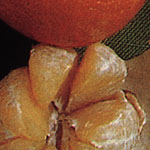

FoodFood InformationFruitBerriesMandarin Oranges
The Tangelo is fairly new on the block. It is a hybrid resulting from
crossing tangerines and other citrus fruit. They are firmer and larger than
tangerines. They have tight, rather than loose, skins and aren't very easily
peeled and segmented. Of the four varieties of tangelos grown in Florida,
three have seeds and are shaped like a tangerine. The fourth is seedless
and shaped like an orange. Of the four varieties, one is a loser, two are
fairly good, and one is out of this world.
The first variety to arrive reaches the market in October and is known as
the Early K. They are shaped like tangerines, have seeds, and are
fairly juicy, but they taste like iodine. Fortunately, they have a rather
short five-to-six-week season.
The next two varieties arrive in November and are called Novas and
Orlando Tangelos. They are almost identical in appearance with the
Early K. They have the same coloring, shape, juice content, and amount of
seeds. However, unlike the Early K, both the Nova and the Orlando have a
fairly sweet but slightly bland flavor. Both varieties arrive in market
three to four weeks after the first arrival of the Early K.
The last tangelo to arrive, usually in mid-December, is called the Mineola.
They are also called Red Tangelos, and in Florida they are called
Honey-belles. The Mineola is a cross between a tangerine and a grapefruit.
It is seedless, chock full of juice and flavor, and, truly one of the finest
citrus fruit around.
Mineolas are easily identified. They are larger and more colorful than the
other kinds of tangelos. Instead of being flat at both ends, they are round
with a very identifiable nipple like bump at the stem end. This is not only
a superb table orange, but, when squeezed, it renders a very colorful, tart-sweet
flavored juice.


Deamer 5/97